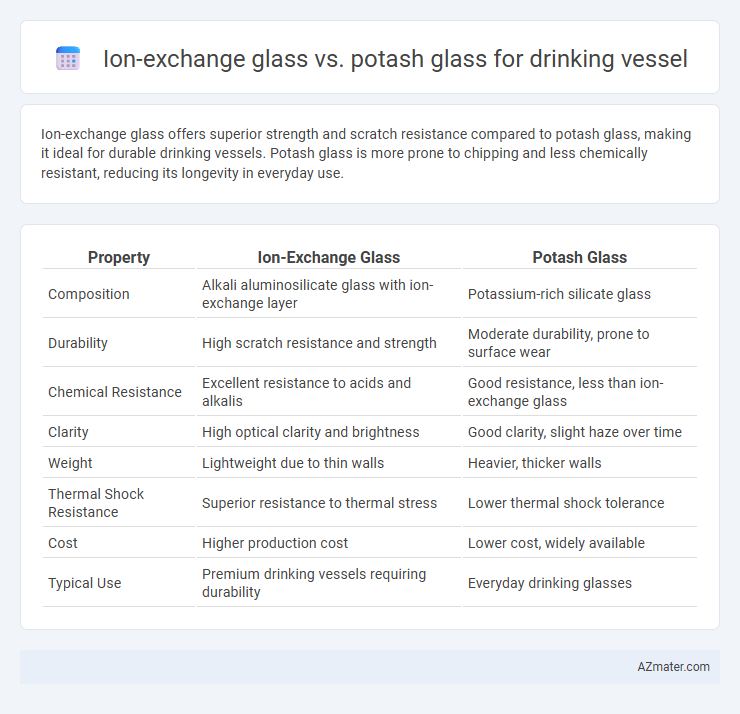Ion-exchange glass offers superior strength and scratch resistance compared to potash glass, making it ideal for durable drinking vessels. Potash glass is more prone to chipping and less chemically resistant, reducing its longevity in everyday use.
Table of Comparison
| Property | Ion-Exchange Glass | Potash Glass |
|---|---|---|
| Composition | Alkali aluminosilicate glass with ion-exchange layer | Potassium-rich silicate glass |
| Durability | High scratch resistance and strength | Moderate durability, prone to surface wear |
| Chemical Resistance | Excellent resistance to acids and alkalis | Good resistance, less than ion-exchange glass |
| Clarity | High optical clarity and brightness | Good clarity, slight haze over time |
| Weight | Lightweight due to thin walls | Heavier, thicker walls |
| Thermal Shock Resistance | Superior resistance to thermal stress | Lower thermal shock tolerance |
| Cost | Higher production cost | Lower cost, widely available |
| Typical Use | Premium drinking vessels requiring durability | Everyday drinking glasses |
Overview of Glass Types for Drinking Vessels
Ion-exchange glass offers enhanced strength and scratch resistance by substituting smaller ions with larger ones, making it highly durable for drinking vessels. Potash glass, composed primarily of potassium oxide, provides superior clarity and chemical durability but is generally less resistant to mechanical stress. Both glass types are popular in drinkware, with ion-exchange glass favored for its toughness and potash glass valued for its aesthetic appeal and chemical stability.
Defining Ion-Exchange Glass
Ion-exchange glass is a type of strengthened glass created by replacing smaller sodium ions with larger potassium ions in the glass surface, significantly enhancing its durability and scratch resistance compared to conventional potash glass. This ion-exchange process results in a compressive stress layer that improves impact resistance, making it ideal for drinking vessels subject to daily use and thermal variations. Potash glass, while containing potassium oxide as a flux, lacks this ion-exchange strengthening, rendering it less robust and more prone to surface damage under similar conditions.
Understanding Potash Glass
Potash glass, known for its high potassium oxide content, offers enhanced clarity and durability compared to standard soda-lime glasses, making it a popular choice for drinking vessels. Unlike ion-exchange glass, which undergoes chemical strengthening for increased scratch resistance and toughness, potash glass inherently provides a smoother surface and greater resistance to thermal shock. Its balanced chemical composition improves both aesthetic appeal and functional longevity, ensuring safer and more enjoyable use in everyday drinkware.
Key Properties: Ion-Exchange Glass vs Potash Glass
Ion-exchange glass exhibits superior strength and scratch resistance compared to potash glass, achieved through a chemical strengthening process that replaces sodium ions with larger potassium ions on the glass surface. Potash glass, containing potassium carbonate as a flux, offers moderate durability and is valued for its clarity and ease of molding but lacks the enhanced toughness of ion-exchange glass. The choice between ion-exchange and potash glass for drinking vessels hinges on desired durability, with ion-exchange glass providing higher resistance to mechanical stress and surface damage.
Strength and Durability Comparison
Ion-exchange glass exhibits superior strength and durability compared to potash glass due to its surface compression layer formed by ion exchange, enhancing resistance to scratches and breakage. Potash glass, while chemically stable and commonly used in traditional drinkware, lacks the enhanced toughness provided by ion-exchange treatment, making it more prone to chips and cracks under impact. The improved mechanical properties of ion-exchange glass make it an ideal choice for long-lasting drinking vessels requiring higher resistance to daily wear and accidental drops.
Clarity and Aesthetic Qualities
Ion-exchange glass exhibits superior clarity and enhanced brilliance due to its chemically strengthened surface, making it more resistant to scratches and maintaining its aesthetic appeal over time compared to potash glass. Potash glass, while often thicker and heavier, tends to have a slightly lower clarity and may develop surface wear more quickly, affecting its visual quality. The advanced durability of ion-exchange glass preserves the pristine look of drinking vessels, thus offering a more elegant and long-lasting aesthetic.
Chemical Resistance and Safety
Ion-exchange glass offers superior chemical resistance compared to potash glass, making it more durable against acidic and basic substances often encountered in beverages. Its enhanced surface strength reduces the risk of leaching harmful ions into drinks, ensuring higher safety for consumers. Potash glass, while commonly used, is more susceptible to chemical degradation and potential ion release, which can compromise both safety and glass longevity in drinking vessels.
Suitability for Everyday Use
Ion-exchange glass offers enhanced durability and scratch resistance, making it highly suitable for everyday drinking vessels that face frequent handling and washing. Potash glass, while chemically stable and with a traditional aesthetic, tends to be softer and more prone to scratches and chips, reducing its practicality for daily use. The superior toughness and longevity of ion-exchange glass provide better performance in routine kitchen environments.
Cost and Manufacturing Considerations
Ion-exchange glass offers enhanced durability and scratch resistance through a chemical strengthening process, resulting in higher manufacturing costs compared to potash glass. Potash glass, commonly used for drinking vessels, is more cost-effective to produce due to simpler raw materials and traditional melting techniques. Manufacturers must weigh the premium price of ion-exchange glass against its longer lifespan, while potash glass provides affordable production with potentially less durability.
Environmental Impact and Sustainability
Ion-exchange glass offers enhanced durability and scratch resistance, reducing the need for frequent replacements and lowering overall environmental waste compared to potash glass. Potash glass, typically made with potassium oxide from natural plant sources, may be more biodegradable but often suffers from lower strength and shorter lifespan, increasing consumption and resource use over time. Choosing ion-exchange glass for drinking vessels supports sustainability efforts by extending product longevity and minimizing raw material extraction and waste generation.

Infographic: Ion-exchange glass vs Potash glass for Drinking vessel
 azmater.com
azmater.com